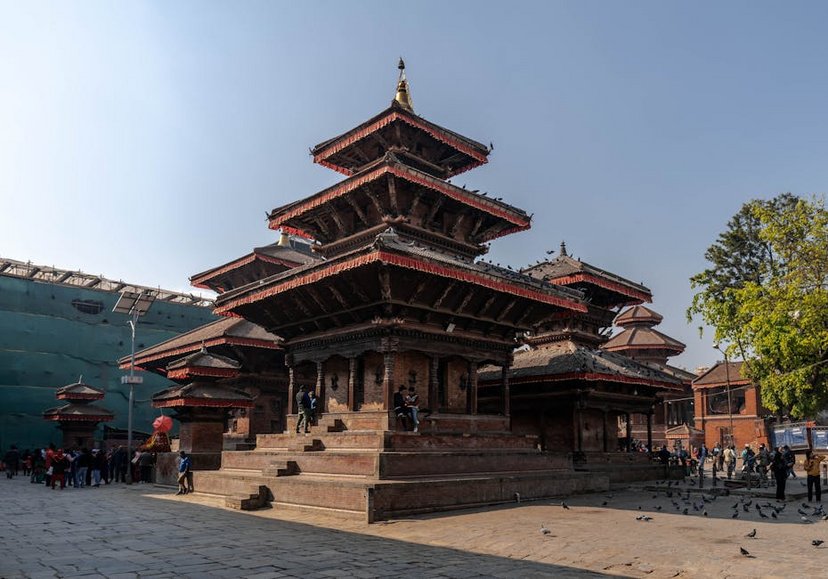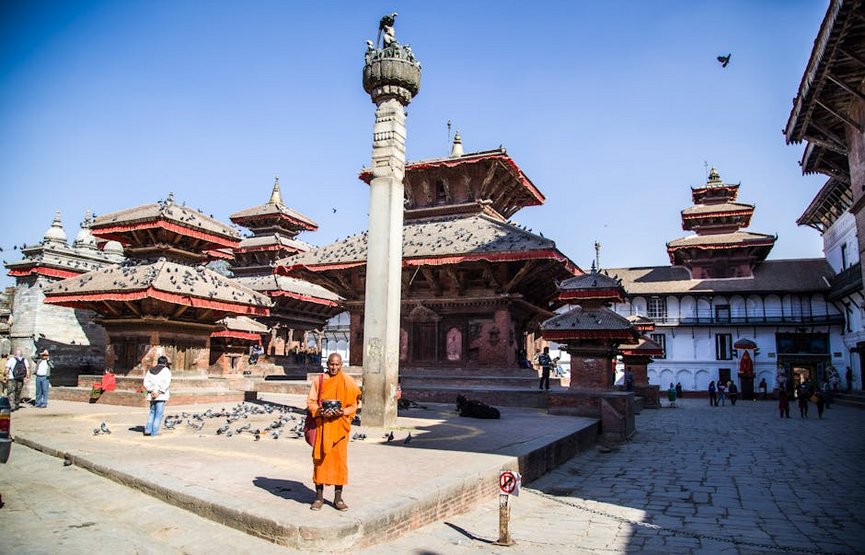Kathmandu Durbar Square
Kathmandu Durbar Square stands as the beating heart of Nepal’s capital, a UNESCO World Heritage Site that whispers tales of ancient kingdoms and living traditions. As you walk through this historic plaza, you’ll find yourself surrounded by intricately carved temples, ancient palaces, and bustling local life that continues just as it has for centuries. This architectural marvel, also known as Hanuman Dhoka Durbar Square, served as the royal palace for the Malla kings and the Shah dynasty, making it one of the most significant cultural sites in the entire Kathmandu Valley. You’ll discover that every corner tells a story, from the towering temples dedicated to Hindu deities to the hidden courtyards where Newari artisans still practice their centuries-old crafts. Visiting Kathmandu Durbar Square isn’t just about seeing historical monuments; it’s about experiencing the soul of a city that has maintained its spiritual and cultural significance through earthquakes, political changes, and modernization. The square remains an active place of worship, celebration, and daily life, offering you an authentic glimpse into Nepal’s rich heritage that simply can’t be found anywhere else.
Kathmandu Durbar Square Essential Information
Before you explore this magnificent UNESCO site, understanding its historical context and practical details will significantly enhance your experience. Kathmandu Durbar Square represents the architectural brilliance of the Newari people, with structures dating back to the 12th century, though most buildings were constructed between the 15th and 18th centuries during the Malla dynasty’s reign. The 2015 earthquake caused significant damage to several monuments, but restoration efforts have been ongoing, with many temples and palaces already rebuilt using traditional methods. You’ll want to allocate at least half a day to properly appreciate the square’s numerous attractions, though history enthusiasts might easily spend a full day exploring every detail. The site operates from sunrise to sunset, with the most vibrant atmosphere during morning and evening prayers when local devotees fill the temples. Remember that this remains an active religious site, so dressing modestly and behaving respectfully is essential throughout your visit.
Historical Significance – What You Need to Know
- The square served as the royal palace until the 19th century when the monarchy moved to Narayanhiti Palace
- It contains buildings representing three main architectural styles: the iconic pagoda style, shikhara style, and dome style
- Many structures feature exquisite wood carvings depicting Hindu mythology, which you’ll want to examine closely
- Budget travelers can manage with $25-40 per day including basic accommodation, local meals, and entrance fees
- Mid-range visitors should budget $50-80 daily for comfortable hotels, better restaurants, and guided tours
- Luxury experiences range from $100-200+ per day featuring heritage hotels, fine dining, and private guides
- UNESCO World Heritage Centre – Kathmandu Valley
- Nepal Tourism Board – Official Travel Information
Visitor Practicalities – Key Details
Entry tickets cost approximately $10 for SAARC nationals and $15 for other foreign visitors, which provides access to the entire square complex except for some specific museum areas that require additional fees. You can purchase tickets at the main entrance near the visitor center, where you’ll also find official guides offering their services for around $20-30 for a comprehensive 2-3 hour tour. While exploring independently is perfectly feasible, hiring a knowledgeable guide will help you understand the historical context and spot details you might otherwise miss. The best lighting for photography occurs during golden hour, just after sunrise or before sunset, when the warm light enhances the reddish brick and dark wood of the ancient structures. Don’t forget to carry bottled water and wear comfortable walking shoes, as you’ll be exploring mostly on foot across uneven surfaces.
Kathmandu Durbar Square Planning Your Trip
Proper planning ensures you make the most of your visit to this cultural treasure while navigating the practical aspects of travel in Nepal. You’ll want to consider the timing of your visit carefully, as weather conditions and local festivals can dramatically affect your experience. The square lies in the heart of Kathmandu’s old town, approximately 6 kilometers from Tribhuvan International Airport, making it easily accessible by taxi or ride-sharing services. While many visitors include the square as part of a broader Nepal itinerary, it deserves dedicated time to appreciate fully. Budget-conscious travelers will find numerous affordable accommodation options within walking distance, ranging from guesthouses to boutique hotels that retain traditional Newari architectural elements. Remember that credit cards aren’t widely accepted at smaller shops and eateries around the square, so carrying sufficient Nepalese rupees in smaller denominations will make transactions smoother throughout your exploration.
Best Time to Visit Kathmandu Durbar Square
The optimal visiting period falls between October and December when the weather is pleasantly cool and dry, with clear skies offering perfect conditions for photography and comfortable exploration. Spring (March to April) also provides excellent conditions with blooming rhododendrons adding color to the cityscape, though temperatures begin to rise toward the end of this period. Monsoon season (June to September) brings heavy rainfall that can make exploration challenging, though the square takes on a mystical atmosphere with fewer crowds. Winter months (January to February) can be quite cold, especially in the early mornings and evenings, but you’ll experience the square with minimal tourist numbers. Various festivals throughout the year transform the square with special decorations and celebrations, with Indra Jatra in September and Dashain in October being particularly spectacular if you don’t mind larger crowds.
Budget Planning and Costs
Essential Preparation Checklist
Ensure you have comfortable walking shoes with good grip as the stone floors and steps can be uneven and slippery, especially during early morning dew or after rainfall. Pack a reusable water bottle to stay hydrated throughout your exploration, though you’ll find numerous shops selling bottled drinks around the perimeter. Carry some Nepalese rupees in smaller denominations for entrance fees, small purchases, and donations at temples, as many places don’t accept credit cards or foreign currency. Download an offline map of Kathmandu since the narrow alleyways surrounding the square can be confusing to navigate, and internet connectivity might be unreliable in certain areas. Learn a few basic Nepali phrases like “Namaste” (hello) and “Dhanyabad” (thank you), as locals appreciate visitors who make an effort with their language.

Kathmandu Durbar Square Top Attractions and Activities
As you explore the square, you’ll discover numerous architectural gems each with their own unique history and spiritual significance. The complex contains approximately fifty temples, courtyards, and monuments, though the exact count varies depending on how one defines the boundaries of the square. You’ll want to start your exploration at the main entrance near the visitor center, then gradually work your way through the various sections, allowing time to absorb the atmosphere and observe daily rituals. Many visitors make the mistake of rushing through the square, but taking time to sit on the steps of ancient temples and watch local life unfold provides some of the most memorable experiences. The square comes alive particularly during morning and evening arati (worship ceremonies), when the sound of bells, chanting, and the scent of incense create an unforgettable sensory experience. Don’t hesitate to strike up conversations with local shopkeepers and artisans, as they often share fascinating stories passed down through generations.
Must-See Highlights
Your visit wouldn’t be complete without admiring the magnificent Taleju Temple, the tallest structure in the square standing at approximately 35 meters, though note that entry is restricted to Hindus only. The Kumari Ghar (Living Goddess House) presents a unique aspect of Newari culture, where you might catch a glimpse of the Kumari, a young girl worshipped as a living deity. Hanuman Dhoka, the ancient royal palace complex, features museums that showcase royal artifacts, though some sections remain closed for restoration post-earthquake. Kasthamandap, believed to have been built from a single tree and giving Kathmandu its name, unfortunately collapsed during the 2015 earthquake but reconstruction efforts continue. The Kal Bhairav stone statue, depicting the fierce manifestation of Shiva, stands as one of the most impressive pieces of stone sculpture you’ll encounter, measuring over 3 meters in height.
Hidden Gems and Local Favorites
Venture slightly beyond the main square to discover the less-crowded Makhan Tole area, where traditional Newari houses feature beautifully carved windows and doors that photographers will adore. The nearby Freak Street, once the hub for hippie travelers in the 1960s and 70s, retains its bohemian atmosphere with quaint cafes and shops selling handicrafts. Local artisans often work in small workshops around the square, creating metal statues, wood carvings, and thangka paintings using techniques passed down through generations. Early morning visitors might witness local women performing puja (worship) at the smaller, less-visited temples, offering an intimate glimpse into daily spiritual practices. The rooftop cafes surrounding the square provide spectacular elevated views, perfect for enjoying a masala tea while watching the square’s activities from above.
Kathmandu Durbar Square Practical Travel Information
Navigating Kathmandu requires understanding the local transportation options and accommodation choices that best suit your travel style and budget. The square sits in the heart of the old city, approximately 5-7 kilometers from most tourist areas like Thamel, making it easily accessible by various modes of transport. You’ll find that taxis offer the most convenient option for getting to the square, though traffic congestion can significantly increase travel time during peak hours. Many visitors choose to walk from Thamel area, which takes about 30-45 minutes through fascinating local neighborhoods that provide authentic cultural experiences. Accommodation options range from budget guesthouses to luxury heritage hotels, with many properties offering traditional Newari architecture and hospitality. Remember that the square area becomes particularly crowded during festivals and weekends, so planning your visit for weekdays might provide a more relaxed experience if your schedule allows flexibility.
| Category | Options/Features | Price Range (USD) |
|---|---|---|
| Budget Accommodation | Basic guesthouses with shared facilities, located in surrounding alleys | $15-30 per night |
| Mid-Range Hotels | Comfortable hotels with private bathrooms, some traditional architecture | $40-80 per night |
| Luxury Heritage Stays | Restored traditional mansions with modern amenities, cultural experiences | $100-200+ per night |
| Transportation | Taxis, ride-sharing, local buses, and walking distances | $2-10 per journey |


